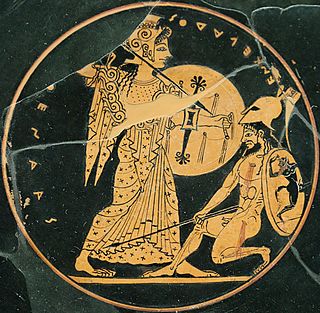
Actaeon, in Greek mythology, was the son of the priestly herdsman Aristaeus and Autonoe in Boeotia, and a famous Theban hero. Through his mother he was a member of the ruling House of Cadmus. Like Achilles, in a later generation, he was trained by the centaur Chiron.

In ancient Greek religion and mythology, Artemis is the goddess of the hunt, the wilderness, wild animals, nature, vegetation, childbirth, care of children, and chastity. In later times, she was identified with Selene, the personification of the Moon. She was often said to roam the forests and mountains, attended by her entourage of nymphs. The goddess Diana is her Roman equivalent.

In Greek mythology, Cerberus, often referred to as the hound of Hades, is a multi-headed dog that guards the gates of the underworld to prevent the dead from leaving. He was the offspring of the monsters Echidna and Typhon, and was usually described as having three heads, a serpent for a tail, and snakes protruding from his body. Cerberus is primarily known for his capture by Heracles, the last of Heracles' twelve labours.

Semele, or Thyone in Greek mythology, was the youngest daughter of Cadmus and Harmonia, and the mother of Dionysus by Zeus in one of his many origin myths.

In Greek mythology, Melicertes, later called Palaemon or Palaimon (Παλαίμων), was a Boeotian prince as the son of King Athamas and Ino, daughter of King Cadmus of Thebes. He was the brother of Learchus.

In ancient Greek religion and mythology, Achelous was the god associated with the Achelous River, the largest river in Greece. According to Hesiod, he was the son of the Titans Oceanus and Tethys. He was also said to be the father of the Sirens, several nymphs, and other offspring.

In Greek mythology, maenads were the female followers of Dionysus and the most significant members of his retinue, the thiasus. Their name, which comes from μαίνομαι, literally translates as 'raving ones'. Maenads were known as Bassarids, Bacchae, or Bacchantes in Roman mythology after the penchant of the equivalent Roman god, Bacchus, to wear a bassaris or fox skin.

In Greek mythology, Admetus was a king of Pherae in Thessaly.

In Greek mythology, Agave, the daughter of Cadmus, was a princess of Thebes and the queen of the Maenads, followers of Dionysus.

In Greek mythology, Alcyoneus or Alkyoneus was a traditional opponent of the hero Heracles. He was usually considered to be one of the Gigantes (Giants), the offspring of Gaia born from the blood of the castrated Uranus.

In Greek mythology, Hippolyta, or Hippolyte, was a daughter of Ares and Otrera, queen of the Amazons, and a sister of Antiope and Melanippe. She wore her father Ares' zoster, the Greek word found in the Iliad and elsewhere meaning "war belt". Some English translations prefer "girdle". Hippolyta figures prominently in the myths of both Heracles and Theseus. The myths about her are so varied it is thought that they may be about different women. The name Hippolyta translates as "she who unleashes the horses", deriving from two Greek roots meaning "horse" and "let loose".
In Greek mythology, Otrera was the founder and first Queen of the Amazons; the consort of Ares and mother of Hippolyta and Penthesilea. She is credited with being the founder of the shrine of Artemis in Ephesus.

In Greek mythology, Telephus was the son of Heracles and Auge, who was the daughter of king Aleus of Tegea. He was adopted by Teuthras, the king of Mysia, in Asia Minor, whom he succeeded as king. Telephus was wounded by Achilles when the Achaeans came to his kingdom on their way to sack Troy and bring Helen back to Sparta, and later healed by Achilles. He was the father of Eurypylus, who fought alongside the Trojans against the Greeks in the Trojan War. Telephus' story was popular in ancient Greek and Roman iconography and tragedy. Telephus' name and mythology were possibly derived from the Hittite god Telepinu.
In Greek mythology, Autonoë was a Theban princess as the eldest daughter of Cadmus, founder of Thebes in Boeotia, and the goddess Harmonia. She was the wife of Aristaeus and mother of Actaeon and possibly Macris.

In Greek mythology, Tethys was a Titan daughter of Uranus and Gaia, a sister and wife of the Titan Oceanus, and the mother of the river gods and the Oceanids. Although Tethys had no active role in Greek mythology and no established cults, she was depicted in mosaics decorating baths, pools, and triclinia in the Greek East, particularly in Antioch and its suburbs, either alone or with Oceanus.

In ancient Greek religion and myth, Nemesis also called Rhamnousia, was the goddess who personified retribution for the sin of hubris: arrogance before the gods.

In Greek mythology, Enceladus was one of the Giants, the offspring of Gaia (Earth) and Uranus (Sky). Enceladus was the traditional opponent of Athena during the Gigantomachy, the war between the Giants and the gods, and was said to be buried under Mount Etna in Sicily.

In Greek mythology, Megara was a Theban princess and the first wife of the hero Heracles.
In Greek mythology, Polydorus or Polydoros was a king of Thebes.
In Greek mythology, Theano is the wife of King Metapontus and queen of Icaria, a small island in the eastern Aegean Sea. The childless Theano adopted the twin sons of Poseidon and Melanippe, claiming to her husband that they were her own. The truth behind their parentage would be revealed years later. Theano played a central role as the main antagonist in the ancient Greek play Captive Melanippe by Athenian dramatist Euripides, which is not preserved.















